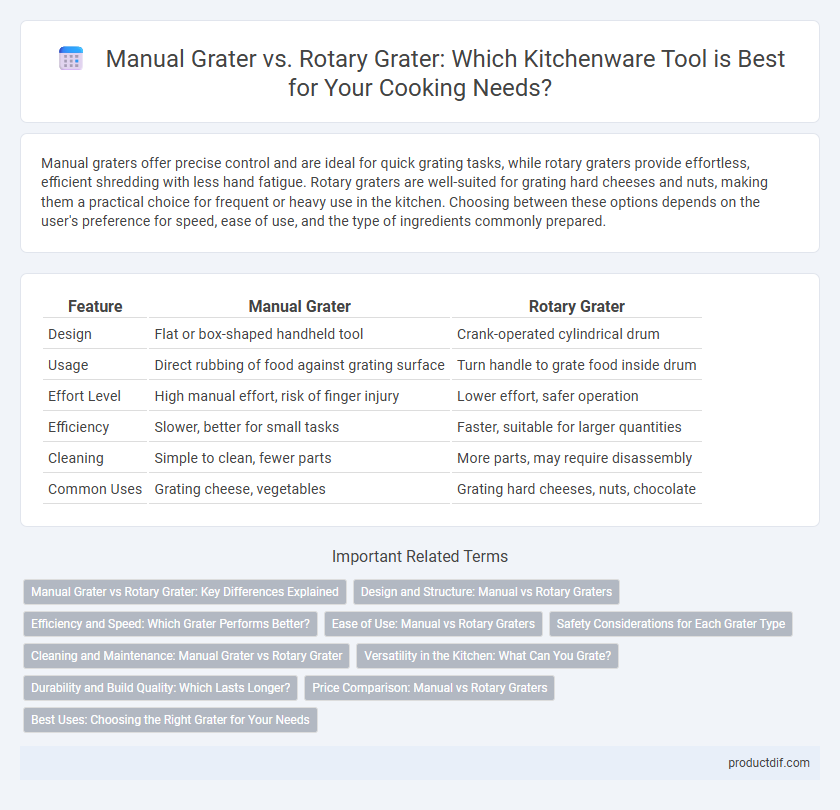Manual graters offer precise control and are ideal for quick grating tasks, while rotary graters provide effortless, efficient shredding with less hand fatigue. Rotary graters are well-suited for grating hard cheeses and nuts, making them a practical choice for frequent or heavy use in the kitchen. Choosing between these options depends on the user's preference for speed, ease of use, and the type of ingredients commonly prepared.
Table of Comparison
| Feature | Manual Grater | Rotary Grater |
|---|---|---|
| Design | Flat or box-shaped handheld tool | Crank-operated cylindrical drum |
| Usage | Direct rubbing of food against grating surface | Turn handle to grate food inside drum |
| Effort Level | High manual effort, risk of finger injury | Lower effort, safer operation |
| Efficiency | Slower, better for small tasks | Faster, suitable for larger quantities |
| Cleaning | Simple to clean, fewer parts | More parts, may require disassembly |
| Common Uses | Grating cheese, vegetables | Grating hard cheeses, nuts, chocolate |
Manual Grater vs Rotary Grater: Key Differences Explained
Manual graters offer straightforward design with a single flat or box-shaped surface for grating, ideal for quick tasks and easy cleaning. Rotary graters feature a drum mechanism that rotates with a handle, providing more efficiency and control for grating harder foods like cheese or nuts. The choice depends on texture preference, speed needs, and ergonomic comfort in the kitchen.
Design and Structure: Manual vs Rotary Graters
Manual graters typically feature a flat or slightly curved stainless steel surface with sharp perforations and a simple handle, designed for straightforward grating tasks. Rotary graters consist of a cylindrical drum housed within a frame, operated by a turning handle that allows continuous grating with minimal effort and enhanced safety. The design of rotary graters offers ergonomic advantages and reduces hand fatigue compared to the more traditional flat manual grater structure.
Efficiency and Speed: Which Grater Performs Better?
Manual graters offer straightforward efficiency for small, quick tasks due to their simple design and ease of use. Rotary graters outperform in speed and consistency by allowing continuous motion, reducing hand fatigue and increasing productivity during larger food preparation. Choosing between them depends on the volume and type of grating required in the kitchen.
Ease of Use: Manual vs Rotary Graters
Manual graters require more physical effort and control to shred ingredients effectively, often resulting in slower processing and increased wrist fatigue. Rotary graters feature a rotating drum mechanism that allows for quicker, more consistent grating with less strain, making them ideal for frequent use or larger quantities. Users seeking convenience and efficiency typically prefer rotary graters for their ergonomic design and smoother operation.
Safety Considerations for Each Grater Type
Manual graters offer straightforward usage but require careful hand positioning to avoid cuts, making finger guards essential for safe operation. Rotary graters reduce direct contact with blades by enclosing the grating mechanism, significantly lowering injury risk during use. However, thorough cleaning and assembly precautions are necessary to prevent accidents with sharp components in both grater types.
Cleaning and Maintenance: Manual Grater vs Rotary Grater
Manual graters require straightforward rinsing and occasional scrubbing to remove food particles, but their open design can make them prone to rust if not dried properly. Rotary graters feature enclosed blades that protect fingers, but their more complex mechanism demands careful disassembly and thorough cleaning to prevent buildup and ensure smooth operation. Frequent maintenance of rotary graters extends their lifespan, while manual graters offer quicker cleanup but may require more attention to avoid corrosion.
Versatility in the Kitchen: What Can You Grate?
Manual graters excel in versatility, efficiently handling a wide range of ingredients such as hard cheeses, vegetables, citrus zest, and nuts with various grating sizes. Rotary graters, designed primarily for softer foods like cheese and chocolate, provide consistent, fine grating but may struggle with tougher items. Choosing between these kitchen tools depends on the variety of ingredients and textures you plan to grate regularly.
Durability and Build Quality: Which Lasts Longer?
Manual graters are typically crafted from stainless steel blades and sturdy plastic or metal frames, offering reliable durability for everyday kitchen tasks. Rotary graters feature a drum design with a crank handle, often constructed with higher-grade metal components that provide enhanced resistance to wear and tear over extended use. In terms of longevity, rotary graters generally outlast manual graters due to their robust build quality and reduced blade exposure, minimizing the risk of dulling or damage.
Price Comparison: Manual vs Rotary Graters
Manual graters typically cost between $5 and $20, making them an affordable choice for basic shredding and grating tasks. Rotary graters are generally priced higher, ranging from $15 to $40, due to their more complex mechanism and enhanced efficiency. Pricing differences reflect the convenience and speed offered by rotary graters compared to the simplicity and lower cost of manual models.
Best Uses: Choosing the Right Grater for Your Needs
Manual graters are ideal for quick tasks such as zesting citrus, grating hard cheeses, or finely shredding vegetables with precision control. Rotary graters excel in grating larger quantities of cheese, nuts, or chocolate efficiently while minimizing hand fatigue, making them perfect for frequent use or when speed is essential. Selecting between manual and rotary graters depends on the volume and type of food you prepare, with manual graters offering versatility and rotary graters providing convenience for repetitive tasks.
Manual Grater vs Rotary Grater Infographic

 productdif.com
productdif.com